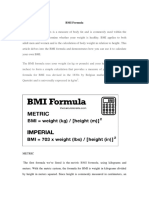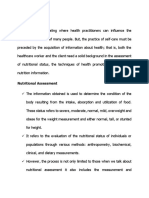Body Mass Index
Body Mass Index
Uploaded by
Angie Lina Ronolo Tapec-CablilanCopyright:
Available Formats
Body Mass Index
Body Mass Index
Uploaded by
Angie Lina Ronolo Tapec-CablilanCopyright
Available Formats
Share this document
Did you find this document useful?
Is this content inappropriate?
Copyright:
Available Formats
Body Mass Index
Body Mass Index
Uploaded by
Angie Lina Ronolo Tapec-CablilanCopyright:
Available Formats
Body mass index
The body mass index (BMI), or Quetelet index, is a heuristic proxy for human body fat based on an individual's weight and height. BMI does not actually measure the percentage of body fat. It was devised between 1830 and 1850 by the Belgian polymath Adolphe Quetelet during the course of developing "social physics".
[1]
Body mass index is defined as the individual's body weight divided by the
2
square of his or her height. The formulae universally used in medicine produce a unit of measureof kg/m . BMI can also be determined using a BMI chart,
[2]
which displays BMI as a function of weight (horizontal axis) and height (vertical axis) using contour lines for
different values of BMI or colors for different BMI categories.
SI units
Imperial/US Customary units
Category
BMI range kg/m
2
BMI Prime
Mass (weight) of a 1.8 metres (5 ft 11 in) person with this BMI.
Severely underweight Underweight
less than 16.0
less than 0.66
less than 51.8 kilograms (8.16 st; 114 lb)
from 16.0 to 18.5
from 0.66 to 0.73 from 0.74 to 0.99 from 1.0 to 1.19
between 51.8 and 59.9 kilograms (8.16 and 9.43 st; 114 and 132 lb) between 59.9 and 81.0 kilograms (9.43 and 12.76 st; 132 and 179 lb) between 81.0 and 97.2 kilograms (12.76 and 15.31 st; 179 and 214 lb) between 97.2 and 113.4 kilograms (15.31 and 17.86 st; 214 and 250 lb) between 113.4 and 129.6 kilograms (17.86 and 20.41 st; 250 and 286 lb) from 129.6 kilograms (20.41 st; 286 lb)
Normal
from 18.5 to 25
Overweight
from 25 to 30
Obese Class I
from 30 to 35
from 1.2 to 1.39
Obese Class II
from 35 to 40
from 1.4 to 1.59
Obese Class III
over 40
over 1.6
Ideal body weight may be defined as the body weight that provides the lowest health risk. This varies widely by individual, but some methods exist so that you can determine your healthy weight range. These methods typically take factors such as height, age and gender into account.
Ideal body weight (IBW) is the weight that people are expected to weigh based on age, sex, and height. The ideal body weight today is used as a tool to calculate the dosage of most medications. There are two different formulas to determine ideal body weight; one formula for men and another for women. The history of the formulas for calculating ideal body weight began in 1871 when Dr. Broca (a French surgeon) created the formula known as Broca's index. An unknown person translated Broca's formula into pounds and inches and modified it to create a formula called the simple rule. In 1974, Dr. Devine converted the simple rule from pounds to kilograms and published that formula for medical use. The Devine formula was intended for use to calculate the dosage of certain medications such as gentamicin, digoxin and theophylline. However, after its publication, the formula became much more widely used and became the most commonly used formula. In 1983, Dr. Robinson published a modification of the Devine formula; this contemporary modification is still in use today to calculate the dosage of most medications. Broca formula Men: Ideal Body Weight (kilograms) = [Height (cm) - 100] - ([Height (cm) - 100] x 10%) Women: Ideal Body Weight (kilograms) = [Height (cm) - 100] + ([Height (cm) - 100] x 15%) Devine formula Men: Ideal Body Weight (kilograms) = 50 + 2.3kg per inch over 5 feet Women: Ideal Body Weight (kilograms) = 45.5 + 2.3kg per inch over 5 feet Hamwi formula Men: Ideal Body Weight kilograms) = 48kg + 2.7kg for each inch over 5 feet Women: Ideal Body Weight (in kilograms) = 45.5kg + 2.2kg for each inch over 5 feet Miller formula Men: Ideal Body Weight kilograms) = 56.2kg + 1.41kg for each inch over 5 feet Women:Ideal Body Weight (kilograms) = 53.1kg + 1.36kg for each inch over 5 feet Robinson formula Men: Ideal Body Weight (kilograms) = 52kg + 1.9kg for each inch over 5 feet Women:Ideal Body Weight (kilograms) = 49kg + 1.7kg for each inch over 5 feet Simple rule Men: Allow 110lbs for the first 5 feet and 5lbs for each additional inch. Women: Allow 100lbs for the first 5 feet and 5lbs for each additional inch. Other formulas Men: Ideal Body Weight (kilograms) = 50kg + 2.3kg for each inch of height over 5 feet Women: Ideal Body Weight (kilograms) = 45.5kg + 2.3kg for each inch of height over 5 feet Note: 1 kilogram (kg) = 2.2 pounds (lb)
You might also like
- The Aesthetic BrainDocument232 pagesThe Aesthetic BrainLouise Battung100% (7)
- NDP Tanhauser FormulaDocument5 pagesNDP Tanhauser FormulaClerenda Mcgrady100% (1)
- PositrimDocument51 pagesPositrimapi-19978941No ratings yet
- Intermediate B Module 2 Navigate Test (Units 9-10)Document6 pagesIntermediate B Module 2 Navigate Test (Units 9-10)Jackson PradaNo ratings yet
- Lesson 3Document29 pagesLesson 3lyracristel.00No ratings yet
- Nutrition Lab 6Document4 pagesNutrition Lab 6kenny don RoggieNo ratings yet
- Body Mass IndexDocument5 pagesBody Mass Indexphani1978No ratings yet
- Fitness & Wellness RevisedDocument33 pagesFitness & Wellness RevisedAbhay YadavNo ratings yet
- Body Mass IndexDocument40 pagesBody Mass IndexLeire Jacutan100% (1)
- AU Module 2 Lesson 2Document13 pagesAU Module 2 Lesson 2Jb PastranaNo ratings yet
- Nutri Chalktalk Session 1Document25 pagesNutri Chalktalk Session 1EMMANUELLE CANTONo ratings yet
- BODY MASS INDEXDocument20 pagesBODY MASS INDEXJoyce Delos ReyesNo ratings yet
- BMI FormulaDocument9 pagesBMI FormulasulimanNo ratings yet
- COMPUTATIONSDocument3 pagesCOMPUTATIONSquin8737No ratings yet
- Nutritional AssessmentDocument61 pagesNutritional Assessmentshahid9212No ratings yet
- Body Mass Index - Wikipedia, The Free EncyclopediaDocument10 pagesBody Mass Index - Wikipedia, The Free EncyclopediaRupam DasNo ratings yet
- Parq and BmiDocument2 pagesParq and BmiClyde SingsonNo ratings yet
- 11 Physical Education Chapter 7Document7 pages11 Physical Education Chapter 7Ayush PalNo ratings yet
- Physical Education Lesson q1Document100 pagesPhysical Education Lesson q1Cathlene GolpoNo ratings yet
- Fitness and Health - Body Mass Index and Waist ManagementDocument17 pagesFitness and Health - Body Mass Index and Waist ManagementEinej JenieNo ratings yet
- Module 2 Lesson 4Document13 pagesModule 2 Lesson 4Roger DarvinNo ratings yet
- Dietary Computation 2023 24Document33 pagesDietary Computation 2023 24Mackoy LoganNo ratings yet
- Grade 12 Phys Ed (2)Document21 pagesGrade 12 Phys Ed (2)aryanph11No ratings yet
- How To Calculate Your Body Mass Index or BmiDocument3 pagesHow To Calculate Your Body Mass Index or BmiMary Grace MendeNo ratings yet
- Body Composition and Weight Management Lecture 2022Document64 pagesBody Composition and Weight Management Lecture 2022Eiva QuinnNo ratings yet
- Nutritional Status AssessmentDocument12 pagesNutritional Status AssessmentChristine Joy MolinaNo ratings yet
- Nutrition Module2Document64 pagesNutrition Module2Kleven carl GindapNo ratings yet
- Dietary Computation: Body Mass Index (BMI) Determination: NCM 105A Nutrition and Diet Therapy LaboratoryDocument4 pagesDietary Computation: Body Mass Index (BMI) Determination: NCM 105A Nutrition and Diet Therapy LaboratoryKryzza LeizellNo ratings yet
- How 2 Compute For D BmiDocument5 pagesHow 2 Compute For D BmiYul DelfinNo ratings yet
- Lab Assignment: Community Nutrition BS-III (6 Semester)Document23 pagesLab Assignment: Community Nutrition BS-III (6 Semester)huzairaNo ratings yet
- 11 Physical Education Study Material Session 2020 2021 Chapter 7Document12 pages11 Physical Education Study Material Session 2020 2021 Chapter 7Peyush NeneNo ratings yet
- Equivalents and Measurements TacioDocument16 pagesEquivalents and Measurements TacioRichell SorianoNo ratings yet
- Lecture 1 - BMIDocument16 pagesLecture 1 - BMIIvy StarrNo ratings yet
- Body CalculatorsDocument85 pagesBody CalculatorsGaurav AroraNo ratings yet
- 1586880748unit 12 Weight Control Management PDFDocument13 pages1586880748unit 12 Weight Control Management PDFkrishmasethiNo ratings yet
- Steps and Formulas To Calculate Daily Needed CaloriesDocument1 pageSteps and Formulas To Calculate Daily Needed CaloriesLoredana CondoiuNo ratings yet
- PE-1 Physical Fitness &: Self-Testing ActivitiesDocument3 pagesPE-1 Physical Fitness &: Self-Testing ActivitiesJiminy Kyle Barrientos ArandelaNo ratings yet
- Physical Education 101: - Body - Mass - IndexDocument11 pagesPhysical Education 101: - Body - Mass - IndexjepsyutNo ratings yet
- Healthy Body CompositionDocument18 pagesHealthy Body CompositionSDasdaDsadsaNo ratings yet
- Body Mass Index - Wikipedia, The Free EncyclopediaDocument10 pagesBody Mass Index - Wikipedia, The Free EncyclopediaSanthosh ReddyNo ratings yet
- Obesity: Methods of AssessmentDocument14 pagesObesity: Methods of Assessmentडा. सत्यदेव त्यागी आर्यNo ratings yet
- Body Fat Calculator Calculate Body Fat PercentageDocument1 pageBody Fat Calculator Calculate Body Fat PercentageMircea TohatanNo ratings yet
- Day 2 Bmi, BMR Rda and Nutritional AssessmentsDocument54 pagesDay 2 Bmi, BMR Rda and Nutritional Assessmentsarchihablani1511No ratings yet
- Lifestyle and Weight Management-EditedDocument26 pagesLifestyle and Weight Management-EditedkitcathNo ratings yet
- Assessment With Estimation of The Ideal (Desirable) Body WeightDocument8 pagesAssessment With Estimation of The Ideal (Desirable) Body Weights.consolacion.geraldkimNo ratings yet
- By Sayyed Nadar ShahDocument9 pagesBy Sayyed Nadar ShahShayan ShayanNo ratings yet
- Impedance Body Composition: BMI CalculatorDocument1 pageImpedance Body Composition: BMI CalculatorRam LakshmiNo ratings yet
- Body Fat CalculatorDocument1 pageBody Fat Calculatorivanvalenzula871No ratings yet
- Dietary Advice For People With Alpha-1 Antitrypsin Deficiency - ENDocument7 pagesDietary Advice For People With Alpha-1 Antitrypsin Deficiency - ENBhaskar Verma WadehraNo ratings yet
- Body Mass Index (BMI) Is Used To EstimateDocument4 pagesBody Mass Index (BMI) Is Used To EstimateJonas AdasijahNo ratings yet
- Body Composition Lab Report-CompleteDocument4 pagesBody Composition Lab Report-CompleteEmmae ThaleenNo ratings yet
- Commu Nity Nutrition Lab ManualDocument37 pagesCommu Nity Nutrition Lab ManualAmmar KhanNo ratings yet
- How Is BMI Calculated?: Measurement Units Formula and Calculation Kilograms and Meters (Or Centimeters)Document1 pageHow Is BMI Calculated?: Measurement Units Formula and Calculation Kilograms and Meters (Or Centimeters)Jose Venus JrNo ratings yet
- LAS in MAPEH Quarter 1Document25 pagesLAS in MAPEH Quarter 1Rovilyn DizonNo ratings yet
- 9 Physiologic Value of FoodDocument40 pages9 Physiologic Value of FoodJason LumayaNo ratings yet
- Physical Education and Health 1Document15 pagesPhysical Education and Health 1Angela A. ArquezaNo ratings yet
- Nutrition & Diet Therapy: By: Odessa S. Bugarin, ManDocument46 pagesNutrition & Diet Therapy: By: Odessa S. Bugarin, ManWincy Salazar100% (1)
- Module Nutrition and Diet Therapy Chapter 3Document5 pagesModule Nutrition and Diet Therapy Chapter 3Maria Pina Barbado PonceNo ratings yet
- Measurement of Body CompositionDocument7 pagesMeasurement of Body CompositionNeha Dubey100% (3)
- Body Mass IndexDocument15 pagesBody Mass Indexapi-266437595100% (1)
- November 17 2022Document15 pagesNovember 17 2022Angie Lina Ronolo Tapec-CablilanNo ratings yet
- HealthDocument1 pageHealthAngie Lina Ronolo Tapec-CablilanNo ratings yet
- Answ RkeyDocument1 pageAnsw RkeyAngie Lina Ronolo Tapec-CablilanNo ratings yet
- CurriculumDocument2 pagesCurriculumAngie Lina Ronolo Tapec-CablilanNo ratings yet
- School Form 8 (SF 8)Document3 pagesSchool Form 8 (SF 8)Jessa Desiree PorrasNo ratings yet
- Background Considerations To Facial EstheticsDocument10 pagesBackground Considerations To Facial EstheticsRosa Natalia Muente RojasNo ratings yet
- Management of Obesity (Sthoulya) A Success Story-A Case StudyDocument11 pagesManagement of Obesity (Sthoulya) A Success Story-A Case StudyMr. chillNo ratings yet
- "The Influence of Culture On Cosmetics Consumer Behavior": Mrs. Hemapatil, DR - BbakkappaDocument7 pages"The Influence of Culture On Cosmetics Consumer Behavior": Mrs. Hemapatil, DR - BbakkappaMudassirah RustamNo ratings yet
- Master List Beneficiaries For School-Based Feeding Program (SBFP)Document25 pagesMaster List Beneficiaries For School-Based Feeding Program (SBFP)Cristina GomezNo ratings yet
- Physical Attractiveness WageraDocument7 pagesPhysical Attractiveness Wageraaftab khanNo ratings yet
- Human Body Weight - WikipediaDocument17 pagesHuman Body Weight - Wikipediapaskalis.bhaskara.unggul.yudhaNo ratings yet
- Calculations - Lecture 1 - TuesdayDocument15 pagesCalculations - Lecture 1 - TuesdayWania ShahidNo ratings yet
- Attraction and LoveDocument68 pagesAttraction and LoveLovely Alpar100% (1)
- FNDRC SGD - N. Assessment Practice QuestionsDocument2 pagesFNDRC SGD - N. Assessment Practice Questionsk7j56tk8z6No ratings yet
- Nutritional Status TemplateDocument1 pageNutritional Status TemplateShangkiee Amora-TamborNo ratings yet
- 2012 Longer Penis OrgasmsDocument10 pages2012 Longer Penis OrgasmsLucano Alvares100% (1)
- Scoring in PFTDocument3 pagesScoring in PFTNoel BandaNo ratings yet
- Cosmetic SurgeryDocument11 pagesCosmetic Surgeryjenish daveNo ratings yet
- Indonesian Female Beauty Concept PDFDocument12 pagesIndonesian Female Beauty Concept PDFArhan0% (1)
- Other InfoDocument25 pagesOther InfoAfaan Shakeeb100% (1)
- Daniel R. Aguinaldo National High SchoolDocument2 pagesDaniel R. Aguinaldo National High SchoolHendrik Edullantes LumainNo ratings yet
- Workout CalendarDocument3 pagesWorkout CalendarDida Produção100% (1)
- Activity 4Document2 pagesActivity 4Coleen BendanilloNo ratings yet
- 21 STDocument20 pages21 STKharl Ashley TahudNo ratings yet
- (New & Improved) TDEE Calculator (Insanely Accurate)Document11 pages(New & Improved) TDEE Calculator (Insanely Accurate)LaraNo ratings yet
- SBFPDocument13 pagesSBFPJaylan GalasiNo ratings yet
- Body Composition and Body Fat PercentageDocument17 pagesBody Composition and Body Fat PercentageNnleinomNo ratings yet
- Warr and KnapperDocument18 pagesWarr and KnapperTendai Elvis MugoviNo ratings yet
- Bmi 10-AlexandriteDocument1 pageBmi 10-AlexandriteNeth Revelo CastilloNo ratings yet
- Tcu Module Pe1 Lesson 4Document8 pagesTcu Module Pe1 Lesson 4Dom RejanoNo ratings yet
- Secrets of Body LanguageDocument126 pagesSecrets of Body LanguagepolocanadaNo ratings yet
- The Influence of Kanye West On Male Young Adults Buying Behaviour On Street Fashion in Kuala Lumpur - Thesis - Alia AlydrusDocument89 pagesThe Influence of Kanye West On Male Young Adults Buying Behaviour On Street Fashion in Kuala Lumpur - Thesis - Alia AlydrusKashif ManzoorNo ratings yet





























































































